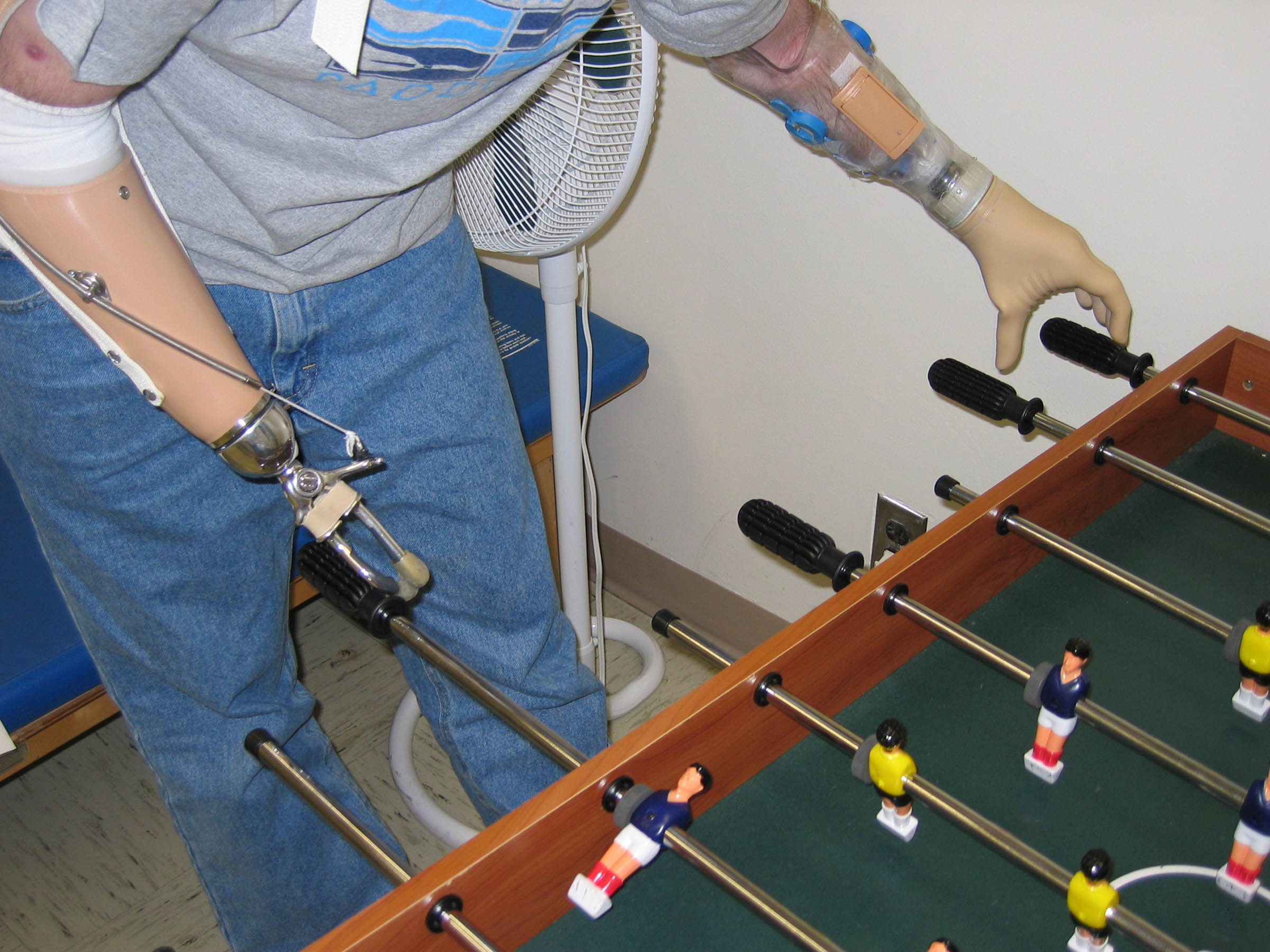|
Proto 2
Proto 2 is the name of the $55 million initiative of the Defense Advanced Research Projects Agency, or DARPA, to create a thought-controlled prosthetic arm. Its predecessor was called Proto 1 and was capable of reasonably complicated movements like rolling the shoulders, wrists, flexing the fingers. etc. Proto 2 is a critical milestone of thought-controlled mechanical arms. It is complete with hand and articulated fingers that can perform 25 joint motions. This dexterity approaches that of a real arm (which makes about 30 motions) — a great improvement over the Proto 1. A person wearing a Proto 2 could "conceivably play the piano".Popular Science magazine, August 2007 The next steps are to shrink the battery, develop more-efficient motors, and refine the bulky electrodes used to read electrical signals in muscles. How it works * Control System Researchers are experimenting with injectable myoelectric sensors (IMES) that detect muscle activity and wirelessly transmit commands ... [...More Info...] [...Related Items...] OR: [Wikipedia] [Google] [Baidu] |
DARPA
The Defense Advanced Research Projects Agency (DARPA) is a research and development agency of the United States Department of Defense responsible for the development of emerging technologies for use by the military. Originally known as the Advanced Research Projects Agency (ARPA), the agency was created on February 7, 1958, by President Dwight D. Eisenhower in response to the Soviet Union, Soviet launching of Sputnik 1 in 1957. By collaborating with academia, industry, and government partners, DARPA formulates and executes research and development projects to expand the frontiers of technology and science, often beyond immediate U.S. military requirements.Dwight D. Eisenhower and Science & Technology, (2008). Dwight D. Eisenhower Memorial CommissionSource The name of the organization first changed from its founding name, ARPA, to DARPA, in March 1972, changing back to ARPA in February 1993, then reverted to DARPA in March 1996. ''The Economist'' has called DARPA "the agency that ... [...More Info...] [...Related Items...] OR: [Wikipedia] [Google] [Baidu] |
Prosthetic
In medicine, a prosthesis (: prostheses; from ), or a prosthetic implant, is an artificial device that replaces a missing body part, which may be lost through physical trauma, disease, or a condition present at birth (Congenital, congenital disorder). Prostheses may restore the normal functions of the missing body part, or may perform a cosmetic function. A person who has undergone an amputation is sometimes referred to as an Amputation, amputee, however, this term may be offensive. Rehabilitation for someone with an amputation is primarily coordinated by a Physical medicine and rehabilitation, physiatrist as part of an inter-disciplinary team consisting of physiatrists, prosthetists, nurses, physical therapists, and occupational therapists. Prostheses can be created by hand or with computer-aided design (CAD), a software interface that helps creators design and analyze the creation with computer-generated Technical drawing, 2-D and 3D computer graphics, 3-D graphics as well as an ... [...More Info...] [...Related Items...] OR: [Wikipedia] [Google] [Baidu] |
Bionics
Bionics or biologically inspired engineering is the application of biological methods and systems found in nature to the study and design of engineering systems and modern technology. The word ''bionic'', coined by Jack E. Steele in August 1958, is a portmanteau from biology and electronics which was popularized by the 1970s U.S. television series ''The Six Million Dollar Man'' and ''The Bionic Woman'', both based on the novel ''Cyborg (novel), Cyborg'' by Martin Caidin. All three stories feature humans given various superhuman powers by their electromechanical implants. According to proponents of bionic technology, the technology transfer, transfer of technology between lifeforms and manufactured objects is desirable because evolutionary pressure typically forces living organisms—fauna and flora—to become optimized and efficient. For example, dirt- and water-repellent paint (coating) was inspired by the hydrophobic properties of the Nelumbo, lotus flower plant (the lotus e ... [...More Info...] [...Related Items...] OR: [Wikipedia] [Google] [Baidu] |
Myoelectric Prosthesis
In medicine, a prosthesis (: prostheses; from ), or a prosthetic implant, is an artificial device that replaces a missing body part, which may be lost through physical trauma, disease, or a condition present at birth (congenital disorder). Prostheses may restore the normal functions of the missing body part, or may perform a cosmetic function. A person who has undergone an amputation is sometimes referred to as an amputee, however, this term may be offensive. Rehabilitation for someone with an amputation is primarily coordinated by a physiatrist as part of an inter-disciplinary team consisting of physiatrists, prosthetists, nurses, physical therapists, and occupational therapists. Prostheses can be created by hand or with computer-aided design (CAD), a software interface that helps creators design and analyze the creation with computer-generated 2-D and 3-D graphics as well as analysis and optimization tools. Types A person's prosthetic device should be designed and assembled t ... [...More Info...] [...Related Items...] OR: [Wikipedia] [Google] [Baidu] |
Research Projects
Research is creative and systematic work undertaken to increase the stock of knowledge. It involves the collection, organization, and analysis of evidence to increase understanding of a topic, characterized by a particular attentiveness to controlling sources of bias and error. These activities are characterized by accounting and controlling for biases. A research project may be an expansion of past work in the field. To test the validity of instruments, procedures, or experiments, research may replicate elements of prior projects or the project as a whole. The primary purposes of basic research (as opposed to applied research) are documentation, discovery, interpretation, and the research and development (R&D) of methods and systems for the advancement of human knowledge. Approaches to research depend on epistemologies, which vary considerably both within and between humanities and sciences. There are several forms of research: scientific, humanities, artistic, economic, ... [...More Info...] [...Related Items...] OR: [Wikipedia] [Google] [Baidu] |




